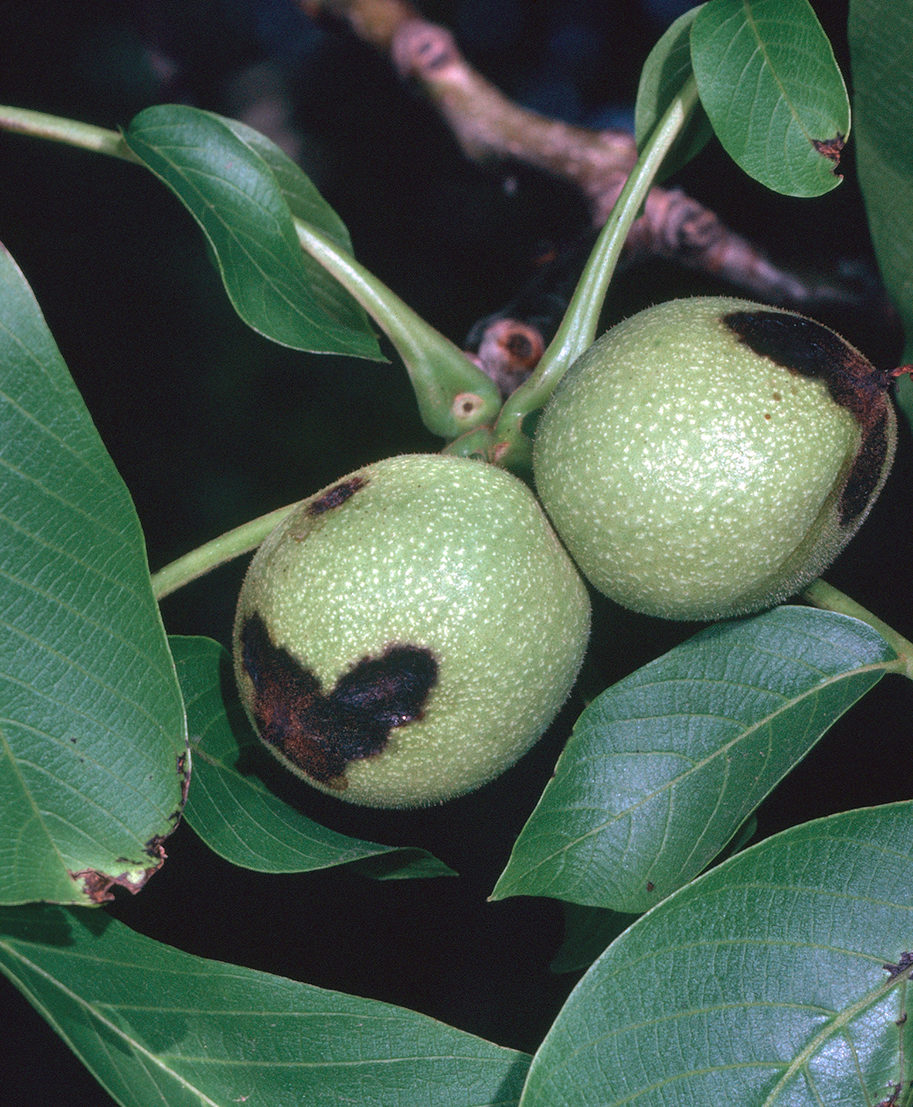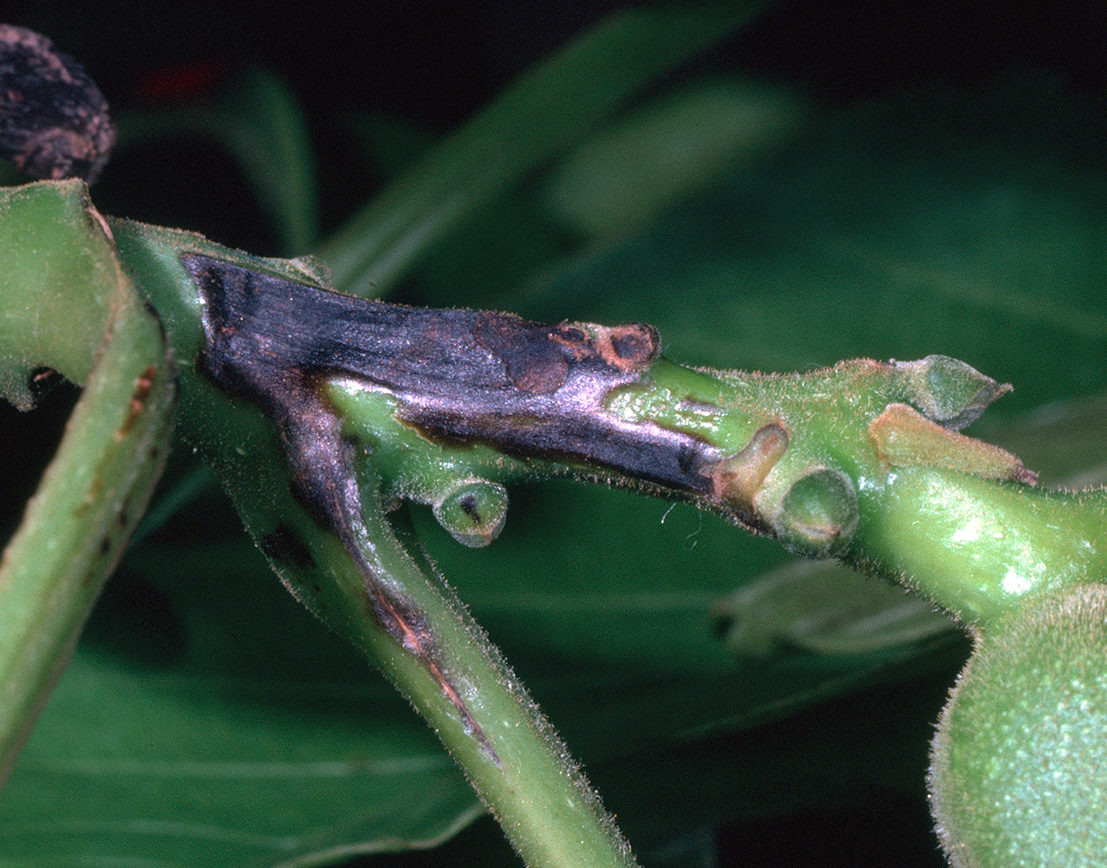Timing spray applications to protect walnut trees from blight infection can be done based on orchard history with the disease and monitoring buds along with the forecasting tool Xanthocast.
UCCE Orchard Systems Farm Advisor Luke Milliron said that timing the first spray depends on the level of disease risk in a particular orchard. If the orchard has high disease history and rain is forecast, a spray at 20- to 40-percent catkin expansion is recommended. In an orchard with low to moderate disease history, a spray is advised at 20-percent prayer stage. In orchards with very low walnut blight infection rates or young orchards with no blight history, growers should consider a spray application at 40-percent prayer stage.
Coming back with a second spray 7 to 10 days later to cover new unprotected foliage is important, Milliron said. Additional sprays are made based on disease pressure, but the first two or three spray applications are critical in protecting trees from spread of this disease.
Walnut blight is a devastating bacterium that can overwinter in between scales of healthy buds. Dormant buds, along with twig canker infections, foster survival of the pathogen from one season to the next.
Rain acts as a carrier, delivering the pathogen to all green tissue including developing flowers and leaves. Spread of this pathogen to developing nuts will cause loss of production and nut quality.

The Sacramento Valley Orchard Source reports that bud infection can result in bud death, and infections in peduncles can lead to twig cankers during the growing season. In a recent study, healthy buds near twig cankers harbored significantly more bacterial cells than buds not near twig cankers, indicating that twig cankers are a source of inoculum.
Milliron said spraying for blight is a protective measure and does not cure the disease.
“Once an orchard has a high inoculum, it is very difficult to claw your way back to a low infection rate. You need an excellent spray program and favorable weather in future seasons.”
Common mistakes with walnut blight control include waiting too late for the first spray application, material rates that are too low to be effective, and poor spray coverage or shortcuts including skipping every other row.
Assessing walnut blight damage levels in June is important in understanding disease pressure in the orchard and timing of the first spray for the next growing season. Milliron advises surveying 10 trees for infected nuts. If there is less than an average of 50 infected nuts per tree, the orchard is in the low risk category. Fifty to 150 infected nuts per tree places the orchard in the moderate category. More than 150 infected nuts per tree places the orchard in the high-pressure category. High disease levels generally mean high bud infection rates and potentially the presence of twig cankers. Mowing orchard middles complicates disease level assessment and means that you must go out multiple times to properly assess the drop of blighted nuts.
Jim Adaskaveg, plant pathologist and professor at UC Riverside, said walnut blight is a disease that requires wetness and favorable temperatures and a susceptible host. Other cultural factors include the three bloom cycles of walnuts, and leaf production in the first month after dormancy, which can form a dense canopy.
Monitoring weather conditions, including temperatures and leaf wetness from dew or rainfall, can provide information about the number and severity of infection periods for a given location. In general, Adaskaveg said, high density plantings take longer to dry out compared to low density orchards.
Growers should be prepared to apply bactericides to trees every 7 to 19 days from pistillate flower emergence (prayer stage) until the last cycle of flowering. This can take 4 to 5 weeks for early blooming varieties like Vina and Ashley, and 3 to 4 weeks for later blooming varieties like Chandler. If dry weather occurs during bloom, the interval for spray applications can be lengthened to 10 to 12 days. If covering the orchard takes longer than 3 to 6 days, use of a second sprayer should be considered, Adaskaveg said.
Growers and PCAs need to know their orchards in terms of cultivars, density, dry times after rain, low areas where dew occurs as well as disease history. Carrying out a good spray application means slower speeds and a pattern that reaches to the top of the canopy.
Besides a survey of infected nuts, bud monitoring and Xanthocast are two forecasting tools. Sacramento Valley Orchard Source states that checking for blight inoculum levels involves sampling dormant buds. Early samples allow more time to develop a disease control strategy. Samples can be collected starting in December and can be collected through early April for late leafing varieties. Buds can be sampled from the time they start to open. Spurs reachable from the ground represent a good sample.
The number of samples to collect depends on orchard history, but 100 3-inch spurs with a fat terminal bud is desired. The spurs should be stored in a paper bag and sent to a plant pathology lab.
Xanthocast forecasting tool uses three temperature ranges and accumulates wetness periods for each temperature range to model for risk of walnut blight. The index for walnut blight is a seven-day cumulative index based on temperature and leaf wetness. The index will range from 0 to 35.
Adaskaveg said that the current rotation program of A) copper plus mancozeb; B) kasugamycin and mancozeb; C) copper plus mancozeb; D) kasugamycin plus mancozeb; or E) copper plus mancozeb, in a four to five application schedule, can provide 90- to 95-percent control of walnut blight under high disease pressure. Three applications in an ABC rotation program can also work well if there is not rain in the 30 days following pistillate flower emergence. Early blooming varieties will need the first two schedules in most years, while later blooming varieties will follow the ABC program.

Cecilia Parsons
Cecilia Parsons has lived in the Central Valley community of Ducor since 1976, covering agriculture for numerous agricultural publications over the years. She has found and nurtured many wonderful and helpful contacts in the ag community, including the UCCE advisors, allowing for news coverage that focuses on the basics of food production.
She is always on the search for new ag topics that can help growers and processors in the San Joaquin Valley improve their bottom line.
In her free time, Cecilia rides her horse, Holly in ranch versatility shows and raises registered Shetland sheep which she exhibits at county and state fairs during the summer.
















